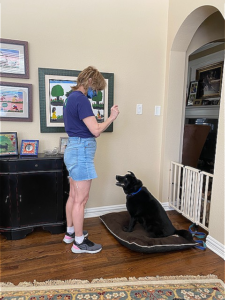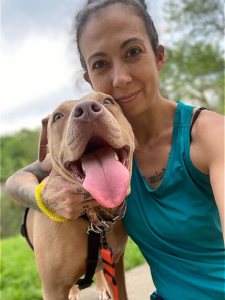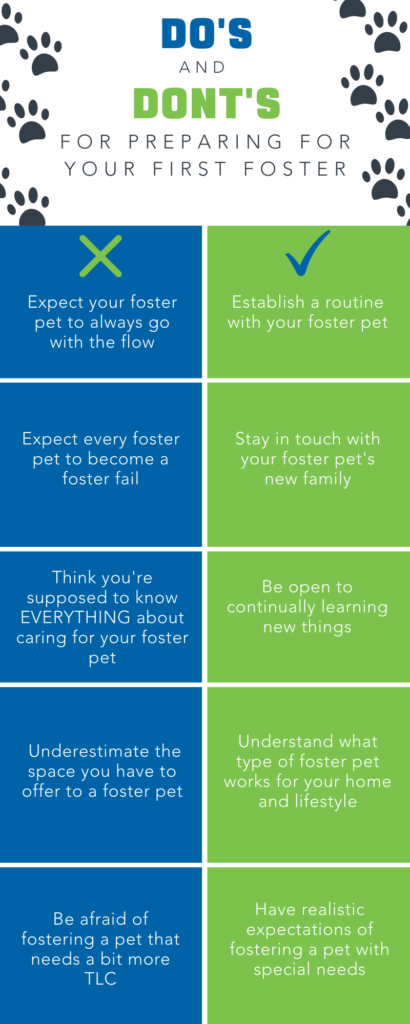 Whether you have pets of your own or have never had a furry friend, preparing for your first foster pet can be nerve-wracking. Trust me, you are not alone.
Whether you have pets of your own or have never had a furry friend, preparing for your first foster pet can be nerve-wracking. Trust me, you are not alone.
Even the most experienced fosters you see today were where you are now, with more questions than answers and wondering, “What did I get myself into” or “Am I ready for my first foster pet?”
(Spoiler Alert: You totally are!)
Regardless of your confidence level, in the next 5 minutes, I’ll give you tips so you feel equipped to care for the first foster pet you bring home!
Let’s jump into do’s and don’ts when preparing for your first foster pet…
DON’T expect your foster pet to always go with the flow
Much like our human relationships, the one we have with our pets is a two-way street about giving and taking.
Don’t expect your foster to bend to your will and your current routine. While sleeping in might be your normal, your dog or cat may need you up 30 minutes before your usual alarm for a quick walk or to be fed. Be prepared to slightly alter the norm to complement your foster’s needs.
DO establish a routine
Much like us humans, our four-legged companions thrive on having a stable routine. Whether it’s:
- Walking your foster dog around the same time of day
- Making sure to incorporate 15-minute playtime throughout the day for your foster cat
- Creating a schedule for when you set out food for your foster pet
- Set aside scheduled time for your pet to decompress
The list goes on and on about how you can personalize your routine daily to maximize your foster’s pets and your happiness. By doing so, your foster is more likely to be calm and collected.
DON’T expect every foster pet to become a foster fail
While I don’t have pets of my own, I do regularly foster kittens and cats. Whenever I am fostering, the number one question I get from family and friends is, “They are so cute! Are you going to keep them?” My answer is always, “Nah, I can’t wait to find them their forever family.”
There will be occasions where you get a foster and you know they are supposed to be in your family; however, this should not be the case for EVERY foster you have.
As foster parents, it’s our job to take care of and get to know our fosters so we can find them families and open our home and hearts to the next foster animal in need. By keeping a constant flow of animals in need entering your home and placing them with permanent families, we are playing a big role in alleviating the number of homeless animals in shelters and on the streets.
This directly results in fewer animals being euthanized. According to the Shelter Animals Count Database for January-November 2020, “In 2020, around 1,986,376 dogs and cats,” in the U.S. were taken in by various animal shelters and rescues. Out of this total number, around 215,392 of these animals did not have a positive outcome from the shelter. Imagine what the number might look like if fosters opened their home until these animals were placed in loving homes. As cheesy as it sounds, being a foster does save lives.
Fostering not only frees up space and resources in shelters but also allows us to closely observe your foster pet, which allows your adoption program to find the best adopter for your foster!
DO stay in touch with your foster pet’s new family
If you’re still not convinced you won’t be able to hand over your foster pet when the day comes, let me tell you something. Helping your foster pet find its forever home will be one of the most joyful experiences of your life.
joyful experiences of your life.
Knowing that I was partly responsible for caring and protecting someone’s future best friend makes me tear up a little. And just because your foster pet no longer lives with you doesn’t mean you can’t still be a part of their lives!
Before handing off my foster, I always ask my foster pet’s adopter if I can stay in touch with them and encourage them to send me updates. I frequently get pictures and videos of my previous furry friends and get to watch them grow up!
While it’s not the same as seeing them every day, it does allow you to have some kind of connection with your foster pet after they’ve moved out.
DON’T think you’re supposed to know EVERYTHING
Remember, every expert was once a beginner. Michael Jordan didn’t come out of the womb winning NBA championships. William Shakespeare didn’t wake up writing greats like Romeo & Juliet and Hamlet without practice and failures. Do you think Elvis Presley automatically had what it took to become the King of Rock and Roll overnight? No!
Much like all the greats mentioned above, you are not expected to know every tip and trick or have a solution to every problem that arises.
Fostering, like many new skills or interests, has a learning curve. Over time, you’ll pick up new information and skills that will make your life as a foster parent easier but that comes from time and experience. While there are many things you can do when preparing for your first foster, some things are learned as they come up. Be patient with yourself on your fostering journey!
DO be open to continually learning new things
While realizing you have a lot to learn is the first step, the next is LEARNING! Whether it be:
- Youtube videos,
- Informational books
- Your rescue’s/shelter’s support channels
- Other fosters
You must be open to asking and receiving information. Remember, there’s a learning curve with fostering, and the only way to flatten this curve is by seeking out more knowledge!
DON’T ignore your foster pet’s nonverbal cues
Downturned ears, tail position, eye dilation, all these words may seem unrelated but they all give us a clue about what our pet is feeling. Like humans, pets have ways to communicate non-verbally.
Before bringing home your foster pet, it would be best to familiarize yourself with the most common nonverbal cues you might see. They do vary from species to species so just make sure you don’t mistranslate one cue for another.
DO be patient with your foster pet.
So you’ve noticed your foster kitten is showing you that they’re skittish or your foster dog is showing signs of being overly aggressive. Now that you’ve identified how to help them overcome this and started the process, it’s all a waiting game.
Foster transformations don’t happen overnight. It will take time. Slowly but surely you’ll see changes that will make you question if this is the same foster you brought home on day one!
While the journey may be frustrating when you are putting so much effort and not seeing immediate results, you must exhibit patience knowing that you’re doing everything you can and you will see results in the near future.
DON’T underestimate the space you have to work with
I am looking at you who:
- lives in a studio or one-bedroom apartment
- has with roommates
- is renting
- doesn’t think their living space is “pet-friendly”
Despite these somewhat reasonable concerns, depending on your foster, they may require less space than you think. For example, a litter kitten or puppies with or without a mama only requires a corner of a room if you have a playpen or appropriate way to confine them. If you don’t have any way to keep them from roaming your living room, a small bathroom or powder room will do.
with or without a mama only requires a corner of a room if you have a playpen or appropriate way to confine them. If you don’t have any way to keep them from roaming your living room, a small bathroom or powder room will do.
Aren’t comfortable having little critters running around once they get old enough? Depending on your lifestyle a single cat or dog may be better.
Live in an apartment like me? Cats or less vocal dogs are totally doable especially if your residence has a nearby dog park.
Once you evaluate your space and your deal-breakers, the possibilities are endless with fostering.
DO understand what works for your home
“Making it work” is always an option when fostering in the space you have but be aware of your limitations and what works for your home.
As previously mentioned, I live in a one-bedroom apartment with no backyard. I am also a full-time student who works. For me, it would be pretty much impossible to have a larger, vocal dog. Not only could it become a nuisance for my neighbors on the other side of my walls, but I would also hate to not have enough time to let my foster dog out to run around and let off some steam.
Another example, if you have a larger pet at home that’s a bit aggressive and bad with newcomers, it may be a good idea to avoid fostering smaller pets, especially if you don’t have an extra space to keep them separate.
Do your best to pre-evaluate what works for your situation and continue to monitor as you foster more animals.
DON’T think your support channels are ignoring you
So you’ve sent a general, non-emergent question to one of your foster support channels. 1 hour turns into 3 hours and you are beginning to wonder if you’ll ever get an answer. Even though animal shelters and rescues try their best to make sure enough staff and/or volunteers are available to keep up with incoming questions or tasks, response time can vary.
Also, keep in mind that most volunteers also have other full-time jobs or other obligations outside of volunteering. Obviously, if your situation requires immediate attention be persistent with getting a reply. However, if your email was non-emergent please be kind and give your support channel some time to read and respond to any questions or concerns you might have.
DO be consistent with communicating with your support channels
While your support channels do have lives of their own, the reason they choose to volunteer in the first place is that they love animals just like you! They want to make sure as a foster you’re equipped to love on and care for your foster to the best of your ability.
If you have any questions, concerns, or information about your foster pet feel free to send us an email or give us a call depending on who you are reaching out to. Consistent communication with your support channels is one of the best ways to get your pet adoption ready and find their furrever home as soon as possible.
DON’T be too hard on yourself
There will be days when it feels like you’ve done everything you can for your foster and there’s still a nagging medical issue, a behavior issue, or something that makes you feel like an awful foster mommy or daddy.
Take a breath and realize that no matter the outcome, you are doing everything in your power to give this animal a second chance. By simply, opening your home to this animal you have changed the trajectory of its life.
Have as much patience with yourself as you do with your foster! 
DO take some ‘me’ time
While fostering is a noble thing to do, we cannot help anyone or anything else if we don’t take care of ourselves.
Think of yourself as a pitcher. When you are full you can do anything and everything. You’re ready to take on every foster that comes your way and is confident in providing the best circumstances to see them grow into the animal they were meant to be! Taking the dog for a walk or attending your foster cat’s medical appointments is a privilege in your eyes.
Now, when your pitcher is empty, you lack the motivation to take the dog for a walk and the last thing you want to do is attend another appointment. Note, this says nothing about your capabilities or commitment to helping animals. It’s more likely a sign you need to slow down and set aside some time for yourself or take a short break from fostering.
Your need to step away to take care of yourself is not selfish or you failing as a foster parent! It is you filling your pitcher in order to make sure you can be the best foster mom or dad you can be.
DON’T think you’re getting emails and paperwork for the sake of busywork
So you’ve received a handful of emails, been handed multiple documents, or told many important dates for appointments or vaccines. Your first instinct may be to gloss over this information but READ IT! Every last word and don’t hesitate to provide any information at your shelter/rescue requests.
I promise, it’s not busy work but information and documentation to ensure excellent care for your foster pet as well as locate their best match for an adopter.
DO read all the documents sent from your foster pet and medical support
Like we just talked about, READ ALL THE WORDS. Any documents sent to you should be read top to bottom.
While the organization you foster with does its best to make the fostering and adoption process straightforward and seamless, your life as a foster will be even more smooth if you are aware of all the processes, requirements, and pending actions you need to take for your foster pet.
This means every email or paper you are given is something worth not only reading through but keeping in a safe place. The information found there could save you some time in the future or save the life of a foster pet. Also, make sure to take note of who to contact in case of medical emergencies so you always have that information handy.
DON’T keep all your foster pet’s cuteness all to yourself
As a long-time foster, I have an album full of dogs, cats, kittens, and puppies that could cure a bad day in seconds.
Adopters are extremely visual! While it helps to read about how adorable or how sweet a foster pet is, seeing the pet is often when potential adopters first fall in love with their future best friend. Don’t hesitate to share these photos and videos with your shelter’s or rescue’s support channels or potential adopters.
That one goofy video of your pup or a sassy shot of your cat could be what captures the attention of their new family.
DO be prepared to become a part-time pet photographer
Now, don’t go buying some expensive camera. Your phone camera will be just enough; however, you will need to become familiar with lying and standing on just about anything to get the right angle.
As a photographer, I found it a completely different, but fun experience to capture my foster pet’s good angles rather than a human’s. Some pets are natural models while others need coaxing with treats and toys to sit still for a minute or two.
DON’T be afraid to foster the underdog/undercat
The cat with ringworm or the dog in need of amputation, and the foster with behavioral issues, the “tough” pets may seem like more of a challenge than you’re up for but they are the pets who need you the most.
While animals with medical needs may have more challenges and need extra attention than most, they are often the fosters that bring us, foster parents, the most joy and best stories.
These pets are also the ones that need the most love and attention. They need a foster that can invest in their healing and stand by them through the transformation they will go through.
If any of you have gardened before or even cooked, the feeling journey you go on with one of these animals is similar if you grew a plant from a seed or made bread from scratch. The pride and admiration you have once you see your foster become healthy and find their new home is a feeling you’ll never forget.
DO have realistic expectations
When you take on an animal with unique health or behavioral issues, do have realistic expectations. Though these animals are a joy to bring into your life and home, they do require special care and more time than regular fosters.
Often, it involves administering medications, more frequent vet visits, or a separate area for them to isolated away from all other animals. Be honest with yourself and ask if you are at a time in your life where you are able to invest in the care this type of foster will require.
If you’re not, that’s okay. There may come a time when you can! Be realistic about what you can take on and a foster match can be found for your comfort and skill level.
If you are able to, then buckle up for the amazing adventure you’re about to embark on with your new foster.
There we have it! 10 Do’s and Don’ts to have you ready to love on your first foster! If you’re ready to take the next step and become a foster with Dallas Pet’s Alive! Click here to learn more about being a foster!





